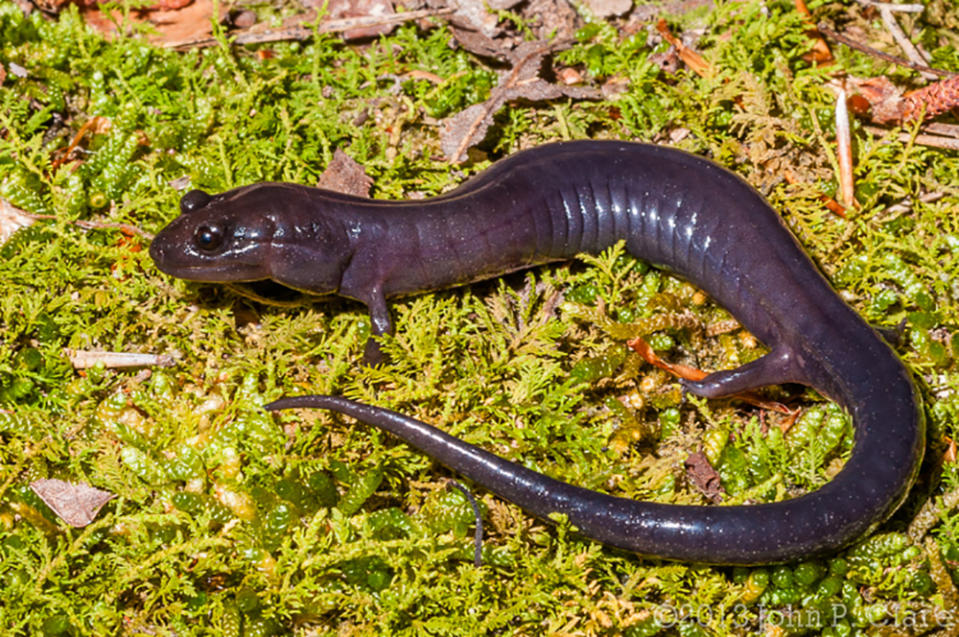Foresters Protect Rare Salamander Found Only in Alabama
Originally published on Rayonier.com
RED HILLS, AL / ACCESSWIRE / August 2, 2023 / The extremely rare Red Hills Salamander is so elusive, no one knew it existed until 1960.
Even then, it was discovered by accident: Biologist Leslie Hubricht found the salamander while searching for snails in Butler County. It was not only a new salamander, but it belonged to a new genus and species all its own. Leslie named it Phaeognathus hubrichti.
As researchers tried to learn more about the long, dark amphibians, it soon became clear why they were so elusive: they prefer to live their entire lives in the safety of burrows in steep cliff sides. The heavily-shaded slopes in Alabama's Red Hills region provide the perfect setting. The cool, wet environment keeps the salamanders moist, which is essential to their survival. They have no lungs and must breathe through their skin.
According to the U.S. Fish and Wildlife Service, there are about 60,000 acres of land on earth that would make a suitable Red Hills Salamander habitat. Within the range of potential habitat, about 20,000 acres where the habitat could exist is on Rayonier land. The area lies between the Alabama and Conecuh Rivers, as shown in this U.S. Fish and Wildlife Service map.
Identifying Red Hills Salamander Habitat
For many years, our foresters have played a role in protecting the federally-threatened species. Using advanced technology like LiDAR mapping, we examine the topography of our forest tracts in the region to ensure all potential Red Hills Salamander habitats are protected.
We also walk the properties, looking for what are called "indicator species." These species also thrive in the area where the salamander lives and help us to identify the habitat. The Big Leaf Magnolia, which has massive, tropical-looking leaves, is an especially noticeable indicator. There are also certain ferns and mosses that indicate a strong likelihood of Red Hills Salamander habitat.
"We take a lot of pride in protecting this species to ensure it does not become endangered. We are very focused on identifying these areas and providing a protected, shaded buffer," says Senior Timber Marketing Manager Billy Geier, who was once fortunate enough to see a salamander poke its head out of a burrow in one of our forests.
Protecting the Habitat
Once a habitat is located, our foresters ensure the area is protected.
In the forest, they'll mark trees so everyone working near the area knows where the boundaries are. They will also digitally block off the habitat in our mapping system. This ensures no one plans forestry activities in that location.
Within the boundary, there will be no chemical applications, no heavy equipment, and no tree harvests within at least a 50-foot perimeter from the habitat in all directions. This ensures the salamander will continue to be shaded, cool and moist.
Our foresters are empowered to decide if measures beyond the recommended guidelines are required to protect this federally-listed species. For example, Timber Marketing Forester Tyler Baxter says his team has chosen to not even thin the trees within the habitat boundary to ensure sunlight doesn't dry it out. When marking the areas, if the recommended 50-foot boundary doesn't provide adequate shade for the habitat, they will expand the area to a 75- or 100-foot buffer.
"When we put these buffers in, we don't allow any cutting behind it. None at all. We want to leave as much shade in the habitat as possible," he says.
Just look at the photo below. The island of tall trees in the center is a protected Red Hills Salamander habitat.
What Researchers Have Learned So Far
While there is still much to be learned about the Red Hills Salamander, researchers have discovered everything it needs to survive is provided without leaving its burrow. The salamanders rarely venture out because they can eat small bugs at their burrows' openings. Their diets include snails, insects, spiders and earthworms, according to this U.S. Fish and Wildlife Service article. They even breed underground: their burrows stretch several feet back in a maze of interconnected tunnels.
In addition to the habitats protected on our land, special properties have been set aside to protect the salamanders by entities including the Alabama Department of Conservation and Natural Resources, the Forever Wild Land Trust and the Alabama Chapter of the Nature Conservancy. You can learn more about their efforts and what they've learned about the salamanders in the online Encyclopedia of Alabama.
To learn more about Rayonier's responsible stewardship, visit our website here.

View additional multimedia and more ESG storytelling from Rayonier on 3blmedia.com.
Contact Info:
Spokesperson: Rayonier
Website: https://www.3blmedia.com/profiles/rayonier
Email: info@3blmedia.com
SOURCE: Rayonier
View source version on accesswire.com:
https://www.accesswire.com/771788/Foresters-Protect-Rare-Salamander-Found-Only-in-Alabama
